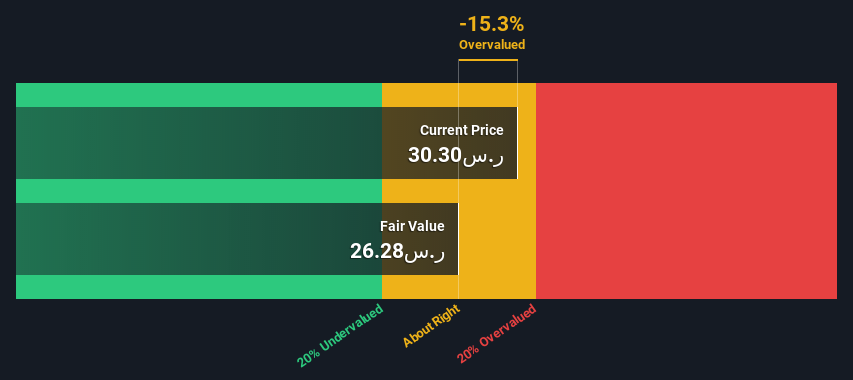- Saudi Arabia
- /
- Infrastructure
- /
- SASE:4031
A Look At The Fair Value Of Saudi Ground Services Company (TADAWUL:4031)

Today we'll do a simple run through of a valuation method used to estimate the attractiveness of Saudi Ground Services Company (TADAWUL:4031) as an investment opportunity by estimating the company's future cash flows and discounting them to their present value. One way to achieve this is by employing the Discounted Cash Flow (DCF) model. There's really not all that much to it, even though it might appear quite complex.
Companies can be valued in a lot of ways, so we would point out that a DCF is not perfect for every situation. For those who are keen learners of equity analysis, the Simply Wall St analysis model here may be something of interest to you.
Check out our latest analysis for Saudi Ground Services
The Model
We use what is known as a 2-stage model, which simply means we have two different periods of growth rates for the company's cash flows. Generally the first stage is higher growth, and the second stage is a lower growth phase. In the first stage we need to estimate the cash flows to the business over the next ten years. Seeing as no analyst estimates of free cash flow are available to us, we have extrapolate the previous free cash flow (FCF) from the company's last reported value. We assume companies with shrinking free cash flow will slow their rate of shrinkage, and that companies with growing free cash flow will see their growth rate slow, over this period. We do this to reflect that growth tends to slow more in the early years than it does in later years.
A DCF is all about the idea that a dollar in the future is less valuable than a dollar today, and so the sum of these future cash flows is then discounted to today's value:
10-year free cash flow (FCF) estimate
| 2023 | 2024 | 2025 | 2026 | 2027 | 2028 | 2029 | 2030 | 2031 | 2032 | |
| Levered FCF (SAR, Millions) | ر.س200.7m | ر.س216.5m | ر.س234.1m | ر.س253.8m | ر.س275.4m | ر.س299.2m | ر.س325.2m | ر.س353.7m | ر.س384.8m | ر.س418.8m |
| Growth Rate Estimate Source | Est @ 7.41% | Est @ 7.85% | Est @ 8.16% | Est @ 8.38% | Est @ 8.53% | Est @ 8.63% | Est @ 8.71% | Est @ 8.76% | Est @ 8.8% | Est @ 8.82% |
| Present Value (SAR, Millions) Discounted @ 13% | ر.س178 | ر.س170 | ر.س163 | ر.س157 | ر.س151 | ر.س145 | ر.س140 | ر.س135 | ر.س130 | ر.س125 |
("Est" = FCF growth rate estimated by Simply Wall St)
Present Value of 10-year Cash Flow (PVCF) = ر.س1.5b
We now need to calculate the Terminal Value, which accounts for all the future cash flows after this ten year period. The Gordon Growth formula is used to calculate Terminal Value at a future annual growth rate equal to the 5-year average of the 10-year government bond yield of 8.9%. We discount the terminal cash flows to today's value at a cost of equity of 13%.
Terminal Value (TV)= FCF2032 × (1 + g) ÷ (r – g) = ر.س419m× (1 + 8.9%) ÷ (13%– 8.9%) = ر.س12b
Present Value of Terminal Value (PVTV)= TV / (1 + r)10= ر.س12b÷ ( 1 + 13%)10= ر.س3.4b
The total value, or equity value, is then the sum of the present value of the future cash flows, which in this case is ر.س4.9b. To get the intrinsic value per share, we divide this by the total number of shares outstanding. Compared to the current share price of ر.س30.3, the company appears around fair value at the time of writing. Valuations are imprecise instruments though, rather like a telescope - move a few degrees and end up in a different galaxy. Do keep this in mind.

Important Assumptions
We would point out that the most important inputs to a discounted cash flow are the discount rate and of course the actual cash flows. Part of investing is coming up with your own evaluation of a company's future performance, so try the calculation yourself and check your own assumptions. The DCF also does not consider the possible cyclicality of an industry, or a company's future capital requirements, so it does not give a full picture of a company's potential performance. Given that we are looking at Saudi Ground Services as potential shareholders, the cost of equity is used as the discount rate, rather than the cost of capital (or weighted average cost of capital, WACC) which accounts for debt. In this calculation we've used 13%, which is based on a levered beta of 0.800. Beta is a measure of a stock's volatility, compared to the market as a whole. We get our beta from the industry average beta of globally comparable companies, with an imposed limit between 0.8 and 2.0, which is a reasonable range for a stable business.
Next Steps:
Although the valuation of a company is important, it ideally won't be the sole piece of analysis you scrutinize for a company. The DCF model is not a perfect stock valuation tool. Rather it should be seen as a guide to "what assumptions need to be true for this stock to be under/overvalued?" If a company grows at a different rate, or if its cost of equity or risk free rate changes sharply, the output can look very different. For Saudi Ground Services, there are three essential elements you should consider:
- Risks: To that end, you should be aware of the 1 warning sign we've spotted with Saudi Ground Services .
- Future Earnings: How does 4031's growth rate compare to its peers and the wider market? Dig deeper into the analyst consensus number for the upcoming years by interacting with our free analyst growth expectation chart.
- Other High Quality Alternatives: Do you like a good all-rounder? Explore our interactive list of high quality stocks to get an idea of what else is out there you may be missing!
PS. The Simply Wall St app conducts a discounted cash flow valuation for every stock on the SASE every day. If you want to find the calculation for other stocks just search here.
New: Manage All Your Stock Portfolios in One Place
We've created the ultimate portfolio companion for stock investors, and it's free.
• Connect an unlimited number of Portfolios and see your total in one currency
• Be alerted to new Warning Signs or Risks via email or mobile
• Track the Fair Value of your stocks
Have feedback on this article? Concerned about the content? Get in touch with us directly. Alternatively, email editorial-team (at) simplywallst.com.
This article by Simply Wall St is general in nature. We provide commentary based on historical data and analyst forecasts only using an unbiased methodology and our articles are not intended to be financial advice. It does not constitute a recommendation to buy or sell any stock, and does not take account of your objectives, or your financial situation. We aim to bring you long-term focused analysis driven by fundamental data. Note that our analysis may not factor in the latest price-sensitive company announcements or qualitative material. Simply Wall St has no position in any stocks mentioned.
About SASE:4031
Saudi Ground Services
Provides ground-handling, aircraft cleaning, passenger handling, and baggage and fuel services for clients and passengers in the Kingdom of Saudi Arabia.
Flawless balance sheet with solid track record.
Market Insights
Community Narratives




